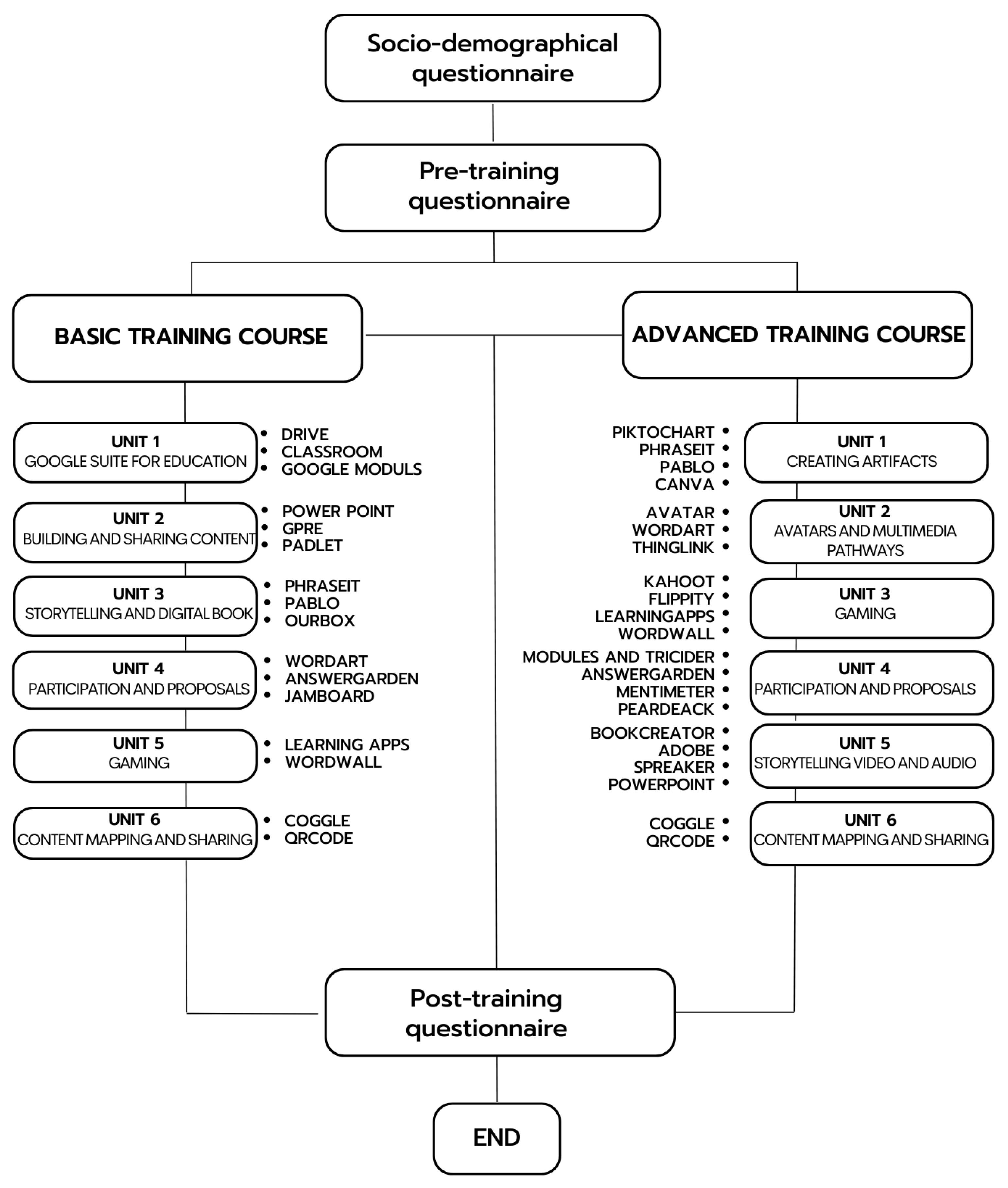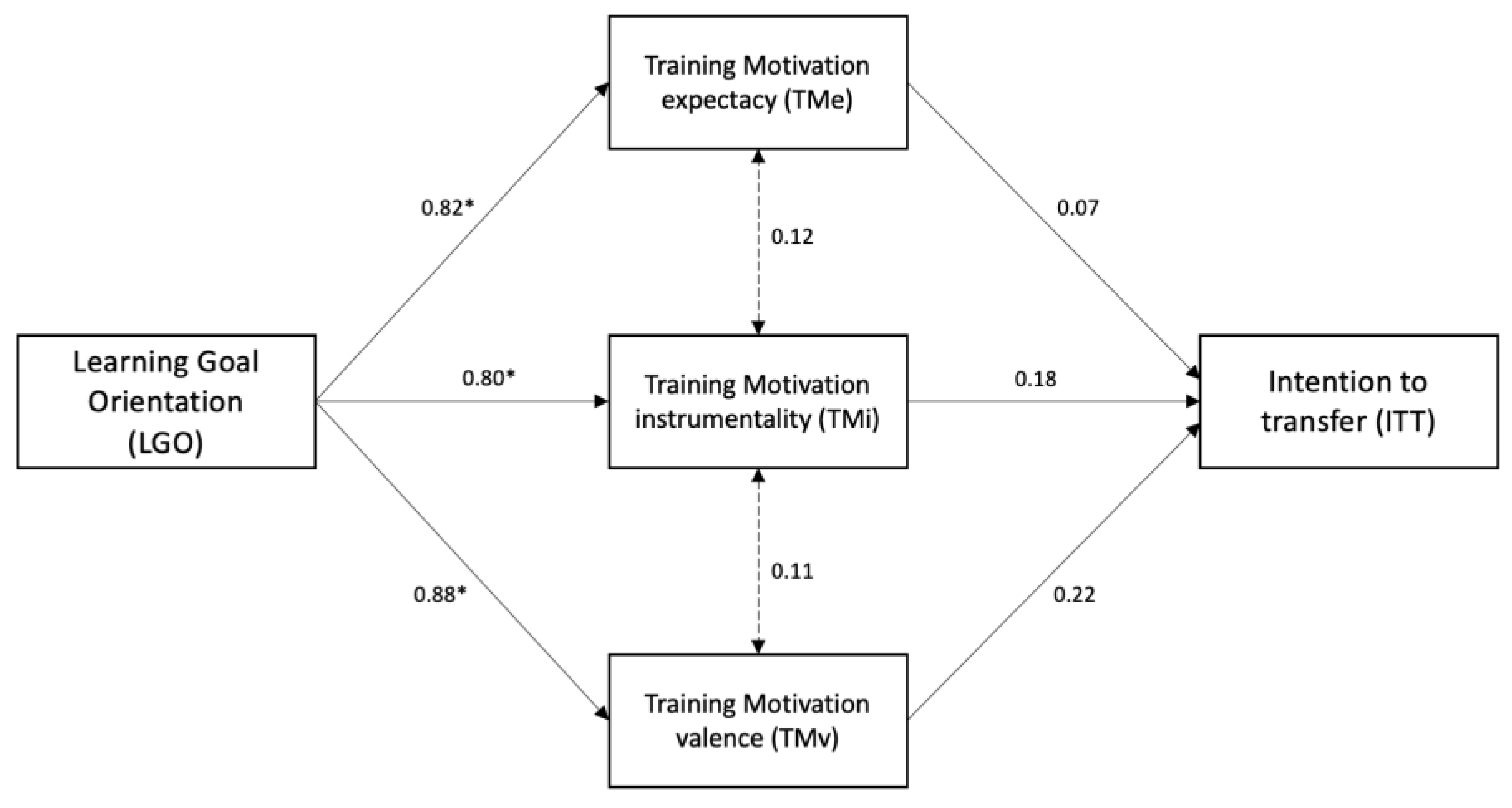Flexible Learning Environments for a Sustainable Lifelong Learning Process for Teachers in the School Context
Abstract
1. Introduction
2. Materials and Methods
2.1. Participants
2.2. The Training Program
2.3. Procedures
2.4. Measures
- Pretraining measures:
- Training motivation measure (TM)
- Learning Goal Orientation (LGO)
- Post-training measure:
- Intention to transfer (ITT)
3. Results
4. Discussion
5. Conclusions
Author Contributions
Funding
Institutional Review Board Statement
Informed Consent Statement
Data Availability Statement
Conflicts of Interest
References
- Bohnsack, R.; Bidmon, C.M.; Pinkse, J. Sustainability in the digital age: Intended and unintended consequences of digital technologies for sustainable development. Bus. Strategy Environ. 2022, 31, 599–602. [Google Scholar] [CrossRef]
- Srivastava, K.; Dey, S. Role of Digital Technology in Teaching-Learning Process. IOSR J. Humanit. Soc. Sci. 2018, 23, 74. [Google Scholar]
- Müller, C.; Mildenberger, T. Facilitating flexible learning by replacing classroom time with an online learning environment: A systematic review of blended learning in higher education. Educ. Res. Rev. 2021, 34, 100394. [Google Scholar] [CrossRef]
- European University Association. Universities without Walls. A Vision for 2030; European University Association: Brussels, Belgium, 2021. [Google Scholar]
- Jo, S.H. Teacher commitment: Exploring associations with relationships and emotions. Teach. Teach. Educ. 2014, 43, 120–130. [Google Scholar] [CrossRef]
- Niemi, H.; Nevgi, A. Research studies and active learning promoting professional competences in Finnish teacher education. Teach. Teach. Educ. 2014, 43, 131–142. [Google Scholar] [CrossRef]
- Vargas, C. Lifelong Learning from a Social Justice Perspective. Education Research and Foresight Working Paper; UNESCO: Paris, France, 2017; Volume 21. [Google Scholar]
- Nicoll, K.; Fejes, A. Lifelong Learning: A Pacification of “Know How”. Stud. Philos. Educ. 2011, 30, 403–417. [Google Scholar] [CrossRef]
- Poquet, O.; De Laat, M. Developing capabilities: Lifelong learning in the age of AI. Br. J. Educ. Technol. 2021, 52, 1695–1708. [Google Scholar] [CrossRef]
- Avvisati, F.; Hennessy, S.; Kozma, R.B.; Vincent-Lancrin, S. Review of the Italian Strategy for Digital School. 2013. Available online: https://www.oecd-ilibrary.org/content/paper/5k487ntdbr44-en (accessed on 16 May 2023).
- Bozat, P.; Bozat, N.; Hursen, C. The Evaluation of Competence Perceptions of Primary School Teachers for the Lifelong Learning Approach. Procedia Soc. Behav. Sci. 2014, 140, 476–482. [Google Scholar] [CrossRef]
- Hwang, G.J.; Fu, Q.K. Advancement and research trends of smart learning environments in the mobile era. Int. J. Mob. Learn. Organ. 2020, 14, 114–129. [Google Scholar] [CrossRef]
- Pépin, L. The history of EU cooperation in the field of education and training: How lifelong learning became a strategic objective. Eur. J. Educ. 2007, 42, 121–132. [Google Scholar] [CrossRef]
- Unwin, T.; Kleessen, B.; Hollow, D.; Williams, J.B.; Oloo, L.M.; Alwala, J.; Mutimucuio, I.; Eduardo, F.; Muianga, X. Digital learning management systems in Africa: Myths and realities. Open Learn. J. Open Distance E-Learn. 2010, 25, 5–23. [Google Scholar] [CrossRef]
- Kelly, K.; Zakrajsek, T.D. Advancing Online Teaching: Creating Equity-Based Digital Learning Environments; Taylor & Francis: Milton Park, UK, 2023. [Google Scholar]
- Hartnett, M. The Importance of Motivation in Online Learning. In Motivation in Online Education; Springer: Berlin/Heidelberg, Germany, 2016; pp. 5–32. [Google Scholar] [CrossRef]
- McCombs, B.L. Motivation and Lifelong Learning. Educ. Psychol. 1991, 26, 117–127. [Google Scholar] [CrossRef]
- Brunstein, J.C.; Heckhausen, H. Achievement motivation. In Motivation and Action, 3rd ed.; Springer: Berlin/Heidelberg, Germany, 2018; pp. 221–304. [Google Scholar] [CrossRef]
- Weiner, B. The development of an attribution-based theory of motivation: A history of ideas. Educ. Psychol. 2010, 45, 28–36. [Google Scholar] [CrossRef]
- Wigfield, A.; Wentzel, K.R. Introduction to Motivation at School: Interventions That Work. Educ. Psychol. 2007, 42, 191–196. [Google Scholar] [CrossRef]
- Wigfield, A.; Cambria, J. Students’ achievement values, goal orientations, and interest: Definitions, development, and relations to achievement outcomes. Dev. Rev. 2010, 30, 1–35. [Google Scholar] [CrossRef]
- Noe, R.A.; Schmitt, N. The influence of trainee attitudes on training effectiveness: Test of a model. Pers. Psychol. 1986, 39, 497–523. [Google Scholar] [CrossRef]
- Rasool, H.; Bashir, F.; Nasir, Z.M. The Other Side of Goal Orientation and Training Outcomes: Mediating Role of Training Motivation. J. Serv. Sci. Manag. 2015, 8, 726–740. [Google Scholar] [CrossRef]
- Burke, L.A.; Hutchins, H.M. Training transfer: An integrative literature review. Hum. Resour. Dev. Rev. 2007, 6, 263–296. [Google Scholar] [CrossRef]
- Colquitt, J.A.; LePine, J.A.; Noe, R.A. Toward an integrative theory of training motivation: A meta-analytic path analysis of 20 years of research. J. Appl. Psychol. 2000, 85, 678–707. [Google Scholar] [CrossRef]
- Zaniboni, S.; Fraccaroli, F.; Truxillo, D.M.; Bertolino, M.; Bauer, T.N. Training valence, instrumentality, and expectancyscale (T-VIES-it) factor structure and nomological network in an Italian sample. J. Workplace Learn. 2011, 23, 133–151. [Google Scholar] [CrossRef]
- Kell, H.J. Do Teachers’ Personality Traits Predict Their Performance? A Comprehensive Review of the Empirical Literature from 1990 to 2018. Res. Rep. 2019, 2019, 1–27. [Google Scholar] [CrossRef]
- Ng, K.H.; Ahmad, R. Personality traits, social support, and training transfer: The mediating mechanism of motivation to improve work through learning. Pers. Rev. 2018, 47, 39–59. [Google Scholar] [CrossRef]
- Laible, M.C.; Anger, S.; Baumann, M. Personality Traits and Further Training. Front. Psychol. 2020, 11, 2713. [Google Scholar] [CrossRef] [PubMed]
- Anderson, S.E.; Groulx, J.G.; Maninger, R.M. Relationships among Preservice Teachers’ Technology-Related Abilities, Beliefs, and Intentions to Use Technology in Their Future Classrooms. J. Educ. Comput. Res. 2011, 45, 321–338. [Google Scholar] [CrossRef]
- Banas, J.R.; York, C.S. Authentic learning exercises as a means to influence preservice teachers’ technology integration self-efficacy and intentions to integrate technology. Australas. J. Educ. Technol. 2014, 30, 728–746. [Google Scholar] [CrossRef]
- Menabò, L.; Skrzypiec, G.; Sansavini, A.; Brighi, A.; Guarini, A. Distance Education among Italian Teachers: Differences and Experiences. Educ. Inf. Technol. 2022, 27, 9263–9292. [Google Scholar] [CrossRef]
- Portillo, J.; Garay, U.; Tejada, E.; Bilbao, N. Self-Perception of the Digital Competence of Educators during the COVID-19 Pandemic: A Cross-Analysis of Different Educational Stages. Sustainability 2020, 12, 10128. [Google Scholar] [CrossRef]
- Trubavina, I.; Dotsenko, S.; Naboka, O.; Chaikovskyi, M.; Meshko, H.; Skovoroda Kharkiv, H.S. Developing digital competence of teachers of Humanitarian disciplines in the conditions of COVID-19 quarantine measures. J. Phys. 2021, 1840, 12052. [Google Scholar] [CrossRef]
- Battistelli, A.; Odoardi, C. Les composantes individuelles et organisationnelles de la motivation à la formation des adultes salariés. In Compétences, Carrières, Evolutions au Travail; Lancry, A., Lemoine, C., Eds.; Editions L’Harmattan: Paris, France, 2004; pp. 185–196. [Google Scholar]
- Button, S.B.; Mathieu, J.E.; Zajac, D.M. Goal orientation in organizational research: A conceptual and empirical foundation. Organ. Behav. Hum. Decis. Process. 1996, 67, 26–48. [Google Scholar] [CrossRef]
- Taber, K.S. The Use of Cronbach’s Alpha When Developing and Reporting Research Instruments in Science Education. Res. Sci. Educ. 2018, 48, 1273–1296. [Google Scholar] [CrossRef]
- The Jamovi Project. Jamovi, Version 2.3. 2022. Available online: https://www.jamovi.org (accessed on 16 May 2023).
- R Core Team. R: A Language and Environment for Statistical Computing; Version 4.1; R Core Team: Vienna, Austria, 2021; Available online: https://cran.r-project.org (accessed on 16 May 2023).
- Bollen, K.A.; Stine, R. Direct and Indirect Effects: Classical and Bootstrap Estimates of Variability. Sociol. Methodol. 1990, 20, 115. [Google Scholar] [CrossRef]
- Preacher, K.J.; Hayes, A.F. Asymptotic and resampling strategies for assessing and comparing indirect effects in multiple mediator models. Behav. Res. Methods 2008, 40, 879–891. [Google Scholar] [CrossRef] [PubMed]
- Alam, A. Mapping a Sustainable Future through Conceptualization of Transformative Learning Framework, Education for Sustainable Development, Critical Reflection, and Responsible Citizenship: An Exploration of Pedagogies for Twenty-First Century Learning. ECS Trans. 2022, 107, 9827–9840. [Google Scholar] [CrossRef]
- Barrick, M.R.; Mount, M.K. The big five personality dimensions and job performance: A meta-analysis. Pers. Psychol. 1991, 44, 1–26. [Google Scholar] [CrossRef]
- Urban, K.; Jirsáková, J. Motivation and personality traits in adult learners. J. Adult Contin. Educ. 2021, 28, 151–166. [Google Scholar] [CrossRef]
- Offerhaus, J. The Type to Train? Impacts of Personality Characteristics on Further Training Participation. SSRN Electron. J. 2013. [Google Scholar] [CrossRef]
- Karacabey, M.F. School principal support in teacher professional development. Int. J. Educ. Leadersh. Manag. 2021, 9, 54–75. [Google Scholar] [CrossRef]
- Ferguson, K.; Frost, L.; Hall, D. Predicting teacher anxiety, depression, and job satisfaction. J. Teach. Learn. 2012, 8, 27–42. [Google Scholar] [CrossRef]
- Learning Policy Institute. Understanding Teacher Shortages: 2018 Update. 2018. Available online: https://learningpolicyinstitute.org/product/understanding-teacher-shortages-interactive (accessed on 16 May 2023).
- Shen, B.; McCaughtry, N.; Martin, J.; Garn, A.; Kulik, N.; Fahlman, M. The relationship between teacher burnout and student motivation. Br. J. Educ. Psychol. 2015, 85, 519–532. [Google Scholar] [CrossRef]
- Olsen, A.; Huang, F. Teacher job satisfaction by principal support and teacher cooperation: Results from the schools and staffing survey. Educ. Policy Anal. Arch. 2019, 27, 11. [Google Scholar] [CrossRef]



| Mean (SD) | |
|---|---|
| Age (years) | 51.6 (8.37) |
| Education (years) | 15.18 (2.42) |
| Job experience (years) | 22.9 (9.67) |
| TM Valence | TM Instrumentality | TM Expectancy | ||
|---|---|---|---|---|
| BIG5_Extroversion | Spearman’s rho | 0.009 | −0.005 | 0.072 |
| p-value | 0.900 | 0.947 | 0.324 | |
| Big5_Agreebleness | Spearman’s rho | 0.317 | 0.294 | 0.348 |
| p-value | <0.001 | <0.001 | <0.001 | |
| BIG5_Conscientiousness | Spearman’s rho | 0.316 | 0.271 | 0.298 |
| p-value | <0.001 | <0.001 | <0.001 | |
| BIG5_Emotional Stability | Spearman’s rho | 0.160 | 0.236 | 0.221 |
| p-value | 0.030 | 0.001 | 0.003 | |
| BIG5_Openess | Spearman’s rho | 0.232 | 0.271 | 0.268 |
| p-value | 0.001 | <0.001 | <0.001 |
Disclaimer/Publisher’s Note: The statements, opinions and data contained in all publications are solely those of the individual author(s) and contributor(s) and not of MDPI and/or the editor(s). MDPI and/or the editor(s) disclaim responsibility for any injury to people or property resulting from any ideas, methods, instructions or products referred to in the content. |
© 2023 by the authors. Licensee MDPI, Basel, Switzerland. This article is an open access article distributed under the terms and conditions of the Creative Commons Attribution (CC BY) license (https://creativecommons.org/licenses/by/4.0/).
Share and Cite
Sangiuliano Intra, F.; Nasti, C.; Massaro, R.; Perretta, A.J.; Di Girolamo, A.; Brighi, A.; Biroli, P. Flexible Learning Environments for a Sustainable Lifelong Learning Process for Teachers in the School Context. Sustainability 2023, 15, 11237. https://doi.org/10.3390/su151411237
Sangiuliano Intra F, Nasti C, Massaro R, Perretta AJ, Di Girolamo A, Brighi A, Biroli P. Flexible Learning Environments for a Sustainable Lifelong Learning Process for Teachers in the School Context. Sustainability. 2023; 15(14):11237. https://doi.org/10.3390/su151411237
Chicago/Turabian StyleSangiuliano Intra, Francesca, Carla Nasti, Rita Massaro, Armando Junior Perretta, Amalia Di Girolamo, Antonella Brighi, and Pietro Biroli. 2023. "Flexible Learning Environments for a Sustainable Lifelong Learning Process for Teachers in the School Context" Sustainability 15, no. 14: 11237. https://doi.org/10.3390/su151411237
APA StyleSangiuliano Intra, F., Nasti, C., Massaro, R., Perretta, A. J., Di Girolamo, A., Brighi, A., & Biroli, P. (2023). Flexible Learning Environments for a Sustainable Lifelong Learning Process for Teachers in the School Context. Sustainability, 15(14), 11237. https://doi.org/10.3390/su151411237





